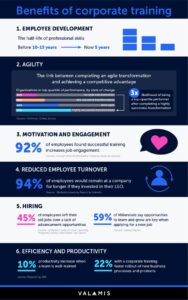THE CHANGING FACE OF CORPORATE TRAINING
In today’s fast changing workplace, where AI can write emails, automate working systems and analyze the markets in just seconds, what truly sets a company apart is its people and how prepared they are. And that’s the reason why corporate training is not just a side function of HR, rather it’s a key tool to keep the employees motivated, skilled and ready for what’s next. Companies that fail to invest and upskill their workforce don’t just fail but they tend to disappear from this highly competitive market. A generation ago, corporate training meant a classroom, a projector, and a printed manual. And now, the entire concept has completely evolved.
Corporate training refers to the structured learning and development programs which are designed to enhance employee’s knowledge, skills and performance at work which contributes to the overall success of the organisation. Nowadays, companies don’t just focus on upskilling their employees but more on reskilling them to adapt to the changing technological advancements. Corporate trainings are conducted to enhance hard skills also referred to as technical skills as well as soft skills which are also known as behavioural skills. In recent times, organisations prefer to spend huge amounts on soft skills as compared to hard skills as they give them better ROI.
Corporate trainings can be of different types and can be tailored according to the needs of different organisations, some of them are mentioned below:
- Technical skills training
With technological advancements, it’s crucial for employees to stay updated and familiar with the latest tools and technologies in their domain to perform their tasks better and faster.
- Soft Skills training
Different kinds of soft skills like emotional intelligence, interpersonal skills, team work, problem solving and conflict management helps employees to collaborate effectively, communicate better colleagues and clients and resolve conflicts with ease at workplace.
- Leadership Development Programs
These programs focus on developing the skills and competencies required for effective leadership, such as communication, decision-making, and strategic thinking. They aim to prepare high-potential employees for future leadership roles and ensure a strong pipeline of talent within the organization.
- Compliance trainings
Every industry has its own rules, and breaking them can be costly. That’s why compliance training matters as it helps employees stay informed and ensures the company stays out of legal trouble.
- Onboarding and Orienting Programs
Starting a new job can be overwhelming, but onboarding programs make the process easier. They introduce employees to the company’s values, rules, and expectations while also providing the tools and training they need to succeed in their new role.
Investing in employee development fosters an environment of growth and continuous learning. The below infographic highlights the key benefits of corporate training in companies:

Corporate training can be delivered through three main methods: instructor-led, online, and blended learning. Instructor-led training takes place in a physical or virtual classroom, offering real-time interaction and hands-on guidance which is ideal for complex topics but often more costly and time-intensive. Online learning, delivers content via digital platforms, allowing employees to learn at their own pace from anywhere. It’s cost-effective and scalable, though it may lack engagement if not well-designed. Blended learning combines both approaches, mixing online modules with face-to-face sessions. This method caters to diverse learning styles, offering flexibility while retaining the benefits of personal interaction and practice.
ROLE AND IMPORTANCE OF LEARNING AND DEVELOPMENT PROGRAMS
Learning and development (L&D) programs are increasingly viewed as a valuable workplace benefit, especially by younger employees. According to a 2021 Gallup survey for Amazon, 66% of workers aged 18 to 24 ranked skills training as the third most important job perk, following only health insurance and disability coverage.
Before designing a training program, it’s crucial to align with organizational goals and assess employee development needs. A common pitfall, as experts point out is launching training initiatives without first identifying the actual skills gap. HR and L&D teams should conduct both Training Need Analysis (TNA) and Training Need Identification (TNI) by evaluating current capabilities, using surveys, and gathering input from managers. This ensures training is targeted, relevant, and resource-efficient.
Traditional slide-based training is being replaced by dynamic, experiential learning. Today’s L&D teams are leading the charge, using creative approaches like gamification and activity-based modules to make training more engaging and effective. Many companies are also investing in offsite programs that blend recreation with learning, boosting collaboration, trust, and team cohesion in the process.

THE FUTURE OF CORPORATE TRAINING
The future of corporate training is shaped by AI, microlearning, and immersive technologies, enabling more personalized, flexible, and engaging learning experiences. These innovations help organizations upskill their workforce efficiently and stay competitive in an ever-evolving, digitally driven business landscape.
REFERENCES
- https://www.valamis.com/hub/corporate-training#trends
- https://www.teachfloor.com/blog/what-is-corporate-training
- https://online.hbs.edu/blog/post/employee-training-development
- https://www.shrm.org/topics-tools/news/all-things-work/how-learning-development-can-attract-and-retain-talent
- https://www.qahe.org/article/the-future-of-corporate-training-trends-and-innovations/





Leave a Reply